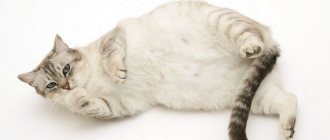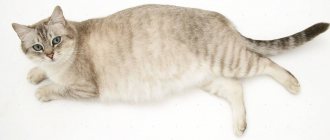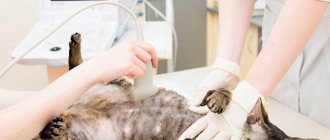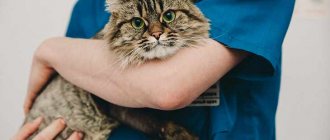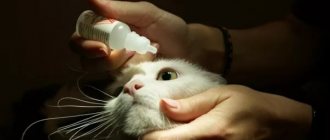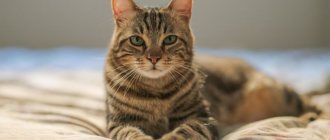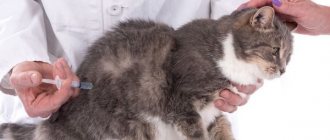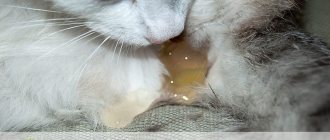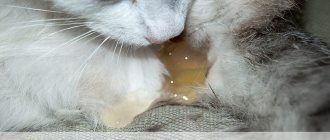The joyful moment for the owners has come - the birth of kittens, but this is always fraught with many questions and dangers. Particular attention should be paid to such a moment of recovery as discharge in a cat after childbirth. Any owner, even one without veterinary education, should be able to distinguish a normal postpartum condition from a pathological one, which requires immediate intervention from a specialist. In this article we will talk about how to find differences in a cat’s condition and what the animal’s hygiene should be.
How should you care for your cat during the postpartum period?
Well, it seems like the dangerous period is behind us, a satisfied mommy is purring, little lumps are feeding on mommy’s tummy. However, you should not relax, because the first 10 days are no less stressful than the last 6 hours before giving birth. Basic rules of care during the postpartum period:
- It so happened that nature gave the cat no more than 10 days to fully recover. After this, mommy should be ready to lead an active lifestyle and be able to hunt.
- Normally, a cat's discharge after birth should last from 1 to 3 weeks. Moreover, discharge first appears in a pregnant cat, about a day before giving birth.
- To make recovery happen faster, kittens sucking colostrum will be great helpers. Because at this time, stimulation of nerve endings occurs, and, as a result, contractions of the uterus. If it so happens that the colostrum does not arrive in a timely manner, then it is necessary to massage the tummy, thus stimulating the production of colostrum. To do this, you need to wet a towel, it is best to use a soft cloth, and very carefully massage your pet’s tummy.
- During contraction of the uterus, mucus and tissue debris are released. And this is a normal process. The discharge that occurs on the first day may be red, brown or greenish. Around day 5, the blood discharge turns into mucous membranes; they may have a slightly pinkish tint. The discharge should be without any foreign odor.
- Normally, a cat should remain active after giving birth; she can easily take care of herself. If the birth process was complicated or she has numerous offspring that can exhaust the pet, she may need the help of her owner. If the animal has matted fur under its tail or on its hind legs, then it is necessary to wipe the animal with a damp cloth.
- Your pet's nest should always be clean; it is best to cover it with a light cloth so that you can better control the animal's secretions, color and quantity. The discharge should not be very copious, but slightly spotting. Ideally, one diaper is enough for 12 hours.
- One of the important points is providing the cat with peace. There is no need to bother her unnecessarily, there is no need to look at the kittens again. Stress can be the source of many health problems.
The reason for contacting a veterinarian may be discharge that lasts less than one and more than three weeks.
Preventive measures and care
First of all, you should prepare for the cat's birth - first create a cozy and warm place, bring clean sheets, tampons and water.
It is necessary to control such things as the sterility of instruments and bedding during childbirth. Also, there should not be many people in the room where replenishment is expected. It’s better to have only the owner and the expectant mother.
To avoid all sorts of problems after the birth of cute whiskers, it is necessary to create comfortable and safe conditions for both cat generations.
- You need to regularly examine the mother cat and pay attention to the intensity, color and smell of the discharge.
- If your pet does not keep the family nest clean, then help her with this - the remaining mucus and blood need to be removed. Be sure to change the bedding and make sure that everything is clean under the mother's tail.
- Provide your cat family with peace and quiet - they need time to adapt to external changes.
- Do not touch the born babies - this causes anxiety in the mother cat, up to the loss of milk and abandonment of the cubs.
- Take care of a high-quality and balanced diet, because the new mother will eat more food. A plate with treats and clean water should always be near your pet. If after giving birth your pet refuses to eat for more than a day, you should call a veterinarian.
- Monitor your temperature throughout the recovery period. Normal temperature ranges from 38 to 39 degrees. A deviation from the norm is a reason to take your pet to the clinic or call a doctor at home.
Can a cat be given Oxytocin after giving birth?
In the last century, Oxytocin was a fairly common drug used after childbirth. At the moment it is considered somewhat outdated, however many veterinarians use it very successfully. This drug stimulates contractions, but it is not recommended for use either immediately before birth or at the time of labor resolution, because the animal may have uterine rupture against this background. Oxytocin is widely used during the expulsion of the placenta, that is, when all the babies are born.
If the owner has given Oxytocin and the pet is bleeding brightly, then this is a clear sign of uterine rupture. In this case, the cat must be taken to the veterinarian as quickly as possible. If the bleeding is dripping, then a hemostatic drug can help in this situation. When the discharge is abundant, nothing will help her except surgery.
What should the owner do?
The owner of the animal should remember a few simple rules:
- Don't interfere. Childbirth is a natural process, and most cats give birth on their own. You just need to unobtrusively observe the pet’s behavior.
- Do not panic. The owner's anxiety will increase the cat's anxiety.
- Be ready to help. It is recommended to consult with a veterinarian in advance about what medications may be required (hemostatic agents, labor inducers, etc.).
Postpartum complications
There are often cases when the labor period occurs with complications, the cause of which may be:
- Postpartum trauma. At this time, the cat has a bright, copious discharge, sometimes accompanied by mucous discharge with blood clots. In addition, the animal becomes restless, has heart rhythm disturbances, rapid, sometimes shallow breathing. When the bleeding continues for more than 10 minutes, if she does not undergo urgent surgery, she will die.
- Inflammatory processes of the uterus. If an infection gets into the birth canal, an inflammatory process may develop. Moreover, inflammation can occur not only at the time of childbirth, but also after it, because the uterus closes for about 10 days. During this time, inflammation may develop, the culprits of which are most often an unclean nest, a dead kitten remaining in the cat's tummy, or an incompletely released placenta. During the inflammatory process of the uterus, bleeding becomes thick and profuse, with a greenish tint. The cat's temperature rises, she is lethargic and apathetic towards kittens.
- Eclampsia is an acute condition in which calcium is washed out, leading to seizures in the form of convulsions. This phenomenon is popularly called milk fever and occurs due to a lack of calcium. As a rule, it appears in the case of multiple pregnancies and improper feeding before the birth of kittens. Mommy’s breathing and heart rate increase, and her temperature rises. She becomes restless, apathetic towards kittens, she experiences disorganization of movements, a convulsive state and increased drooling.
- Uterine prolapse. This phenomenon may occur due to sagging or hydrocele of the uterus, a large number of kittens, due to rapid birth, short umbilical cord of the fetus, due to birth without water, that is, the so-called dry birth. At this time, part of the uterus may protrude from the vulva. The cat has great difficulty going to the toilet, both small and large. She constantly pushes and arches her back. In this case, only a veterinarian can help her; most often, surgery is performed to remove the uterus.
Nature of the discharge
By the nature of the discharge, you can tell whether the cat has postpartum problems:
- Bloody discharge with a greenish tint indicates an inflammatory process of the uterus. In this case, you need to contact your veterinarian and check whether there is a dead kitten in the cat’s womb or whether the placenta has completely passed. If the animal is not given timely assistance, intoxication of the body may occur.
- Mucous discharge of a yellowish, gray tint is also a bad sign; they indicate that an inflammatory process is taking place in the uterus.
- Bloody discharge with milk indicates an inflammatory process in the genitals or genitourinary system.
Symptoms of pathological discharge
Of course, the main clinical sign for all these pathologies will be vaginal discharge, but various variations are still possible due to the deterioration of the animal’s general condition:
- As we have repeatedly written above, pathology should be suspected if any uncharacteristic discharge appears immediately after childbirth or a few days after it.
- At the same time, cats begin to constantly lick the genital area. Sometimes they get so carried away by this activity that they even stop caring for their kittens.
- Often, with inflammatory diseases of the genitourinary system, the pet experiences severe pain, which is why it begins to behave inappropriately. She constantly runs, meows, and can literally roll on the floor. The animal cannot even feed the kittens normally. However, in such cases, we would recommend feeding babies artificially, since pathogenic microflora can get into the milk.
- A fairly characteristic symptom is constant, non-stop urination. This happens because the cat is constantly pushing.
- For the same reason, constant “big” hikes or involuntary bowel movements are possible. Due to the constant mixing of discharge from the genitals and feces, brown discharge may be observed.
- Apathy, feverish state, sharp increase in thirst.
Remember that if your pet is in a lethargic state and (especially) a noticeable drop in its overall body temperature, you must immediately call a veterinarian. These signs indicate septic processes. If you delay, your cat may very well die.
Treatment
To prescribe the necessary treatment, the veterinarian conducts an examination using palpation, ultrasound, and x-rays and consists of the following:
- For minor bleeding caused by Oxytocin, veterinarians prescribe hemostatic agents; if significant blood loss is observed, then surgical intervention will have to be performed on the animal.
- If a cat gets sick, her temperature rises, then the kittens need to be isolated from their mother and transferred to artificial feeding.
- When a veterinarian prescribes gentle treatment, the owner may not have to face the question of separating the mother from the kittens.
- If a cat is diagnosed with inflammation of the uterus, then in addition to antibiotic therapy, the veterinarian prescribes medications that lead to an increase in tone. As a result, the remaining tissue is removed from the uterus. In addition to medications, you can massage your tummy. With timely treatment, a complete cure occurs in your pet after 2 weeks.
- Immunostimulants and vitamins will help the animal recover after a difficult period.
- In case of inflammatory processes in a cat, it is necessary to conduct a milk test. If it turns out to be infected, the kittens must be separated from their mother.
If your cat has bloody discharge, the situation needs to be assessed immediately. If complications occur, you should contact your veterinarian for medical help as soon as possible. It is very important that assistance is provided in a timely manner, because the life of a young mother depends on it.
When do you need veterinary help?
However, in many cases, postpartum discharge is one of the symptoms of serious pathologies. You should immediately contact a veterinarian in the following cases:
- If during the birth process the animal does not have all the placenta released. For example, a cat gave birth to five kittens, but three or four placentas came out. This condition threatens the pet with a dangerous disease - purulent inflammation of the uterus. This severe pathology often has to be treated surgically.
- If a large amount of discharge comes out of the loop, this most often indicates a disease.
- If an animal comes out with pus, this always indicates severe inflammation or tumor. Moreover, the pathological process does not always develop in the genitals. Such discharge may be a sign of bladder cancer.
- It is necessary to contact a veterinarian if discharge was observed during pregnancy.
- If an animal experiences heavy and prolonged bleeding, this should always be a reason to immediately contact a specialist.
- If a cat suffers from poor blood clotting, and after giving birth the animal experiences red discharge, this is a very ominous sign. With hematological pathologies, any damage received during childbirth can bleed for a very long time. In severe cases, the animal may die from blood loss.
- It is also necessary to urgently contact a specialist if discharge is observed after a difficult birth that occurred with ruptures of the mucous membrane. In such cases, cats often develop inflammation of the vagina - vaginitis.
- In rare cases, primiparous animals develop a fistula between the intestines and genitals. This is an extremely dangerous pathology that can be complicated by sepsis. In this case, not only blood is released from the loop, but also a small amount of feces.
- If your cat has had chronic urinary incontinence in the past, you should be examined by a veterinarian. In this case, urine constantly leaks and irritates the loop area. Over time, inflammation develops, accompanied by discharge.
Next, we will look at the different types of postpartum discharge and the possible reasons for their appearance.
Video “Birth of a kitten”
We do not recommend watching this video for impressionable or faint-hearted people - it shows the process of giving birth to a kitten and how the cat cares for it immediately after birth.
Was this article helpful?
Thank you for your opinion!
The article was useful. Please share the information with your friends.
Yes (100.00%)
No
X
Please write what is wrong and leave recommendations on the article
Cancel reply
Rate the benefit of the article: Rate the author ( 3 votes, average: 5.00 out of 5)
Discuss the article:
